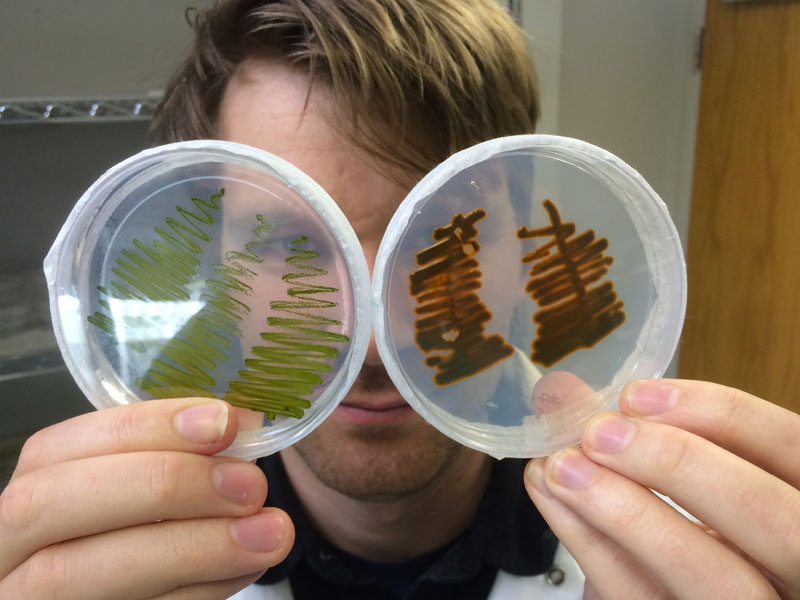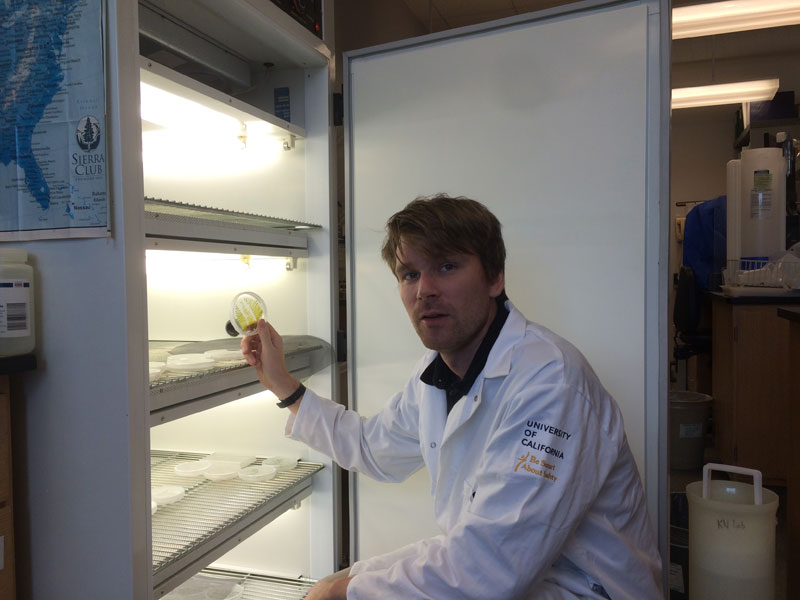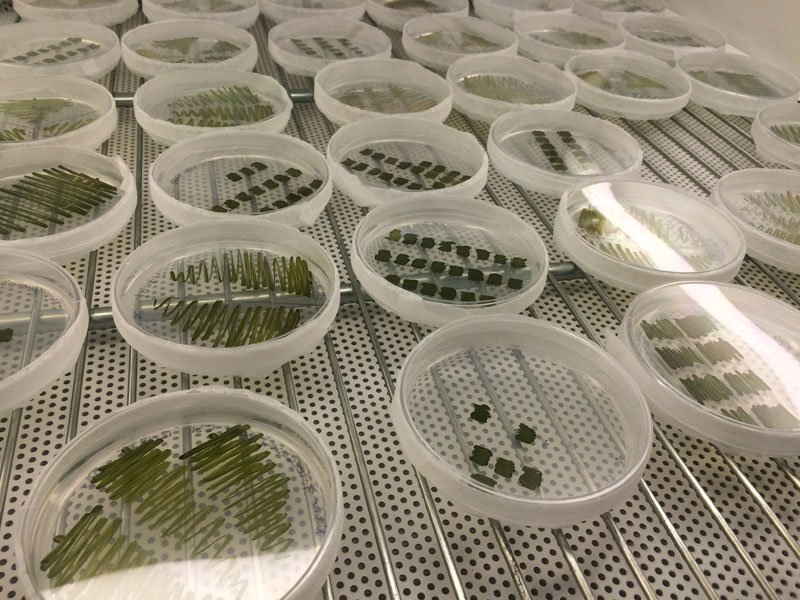The Future of Food Coloring May Be Very Slimy
A Danish scientist has begun working on a way to use algae to color candies and cheeses.
The Future of Food Coloring May Be Very Slimy
A Danish scientist has begun working on a way to use algae to color candies and cheeses.

Currently, there are only two ways to get the bright oranges and reds used by many food manufacturers for things like candy and cheddar cheese. One way involves extracting the colors from carrots and fruits like the clementine. The other way involves synthetic fabrication.
“But that’s not always the most economically feasible way,” says Andersen Ranberg. Fruit crops can demand a lot of resources, a lot of land, and lots of fresh water, he points out. “With algae, you can grow a crop utilizing salt water, which we have in very high abundance all over the world.”
Andersen Ranberg has been awarded $313,000 from the Danish Council for Independent Research to study ways to introduce genes into algae that will create a form of carotene – a natural substance produced by green plants and algae to regulate the intake of radiation from sun, which can also turn things orange.
No one has ever used algae this way before, and part of Andersen Ranberg’s work – conducted during the next few years at the University of California Berkeley – will be to determine not only if carotene can be produced this way but also how feasible and economical it would be to do on a large scale. In the past he’s researched the use of insects in the making of cosmetic pigments.
Andersen Ranberg’s algae food coloring idea is appealing to those working to eliminate synthetic, chemically-produced dyes from American diets. Lisa Lefferts from the Center for Science in the Public Interest is working on a new report, released today, which details data connecting synthetic food dyes to adverse behavior in children. Some are known carcinogens. Some studies have shown a strong link between the synthetic dyes and an increase in hyperactivity among children.
“The research is plentiful: synthetic food dyes adversely affect some children – not all children, but some children. And for those children, the adverse reactions make it hard for them to well in school, affect their relationships, and affect the entire family,” Lefferts says. “Clearly, if companies can get these dyes out of food, we could significantly help children.”
Although she’s not heard of the use of algae for food dye production previously, Lefferts says it “sounds like a great idea.” Other naturally derived carotenoids, she says, have been found to be very safe, especially when compared to the synthetic alternatives.


John B. Miller, from Western Michigan University, says using algae as a colorant shows promise for creating a high-value agricultural crop. Miller is an algalologist – a biologist who specializes in the study of algae. He cautions that the concept may not be as sustainable as some imagine. To get a particular, reliable strain of algae for this kind of production, Miller says, you’d have to grow a monoculture, which means you could grow only one kind of algae and nothing else in chosen lab or farm location.
“You run into problems in all agriculture runs into when you have a monoculture,” Miller says, comparing the situation to monocrop problems in other products such as wheat, which can become susceptible to wheat rust. “If you get a bacterium, if you get a phage, if you get a fungus – you can wipe out the whole crop in no time at all.”
Using algae as a colorant shows promise for creating a high-value agricultural crop.
But also, growing a particular kind of algae for a specific color compound is very different, Miller points out, from the kind of harvest of random rogue algae often used for products like biofuels. When producing biofuels you mostly are interested in abundance and often don’t need to worry about what type you harvest.
Although some like to claim that algae need little more than CO2 and sunlight to grow, Miller assumes that this kind of dye production would demand some specific strain of red algae, which need all of the same things familiar to farmers growing crops on land: nitrogen, phosphorous, and trace minerals. So he’s a bit skeptical about any claims that this could be an inexpensive agricultural venture.
On the other hand, the growing cycle is very short for most algae – only seven to 14 days until harvest. Terrestrial plants used for food coloring can take anywhere from 70 to 120 days.
“In that way the algae really is a super crop,” Miller says.
“The important part for me,” says Andersen Ranberg, “is that you could potentially get crops that could be grown on less attractive lands.” Whereas terrestrial food crops demand land with rich soil and good drainage, algae could be grown in a multitude of locations regardless of past land use or soil quality. It could perhaps be grown indoors in multi-level warehouses or other similar facilities.
Andersen Ranberg even envisions future systems set up in cities, maybe in schools where children were learning about hydroponics. “They could become small algae-neers, you could say.”
Follow us

This work is licensed under a Creative Commons Attribution-NoDerivatives 4.0 International License.
Want to republish a Modern Farmer story?
We are happy for Modern Farmer stories to be shared, and encourage you to republish our articles for your audience. When doing so, we ask that you follow these guidelines:
Please credit us and our writers
For the author byline, please use “Author Name, Modern Farmer.” At the top of our stories, if on the web, please include this text and link: “This story was originally published by Modern Farmer.”
Please make sure to include a link back to either our home page or the article URL.
At the bottom of the story, please include the following text:
“Modern Farmer is a nonprofit initiative dedicated to raising awareness and catalyzing action at the intersection of food, agriculture, and society. Read more at <link>Modern Farmer</link>.”
Use our widget
We’d like to be able to track our stories, so we ask that if you republish our content, you do so using our widget (located on the left hand side of the article). The HTML code has a built-in tracker that tells us the data and domain where the story was published, as well as view counts.
Check the image requirements
It’s your responsibility to confirm you're licensed to republish images in our articles. Some images, such as those from commercial providers, don't allow their images to be republished without permission or payment. Copyright terms are generally listed in the image caption and attribution. You are welcome to omit our images or substitute with your own. Charts and interactive graphics follow the same rules.
Don’t change too much. Or, ask us first.
Articles must be republished in their entirety. It’s okay to change references to time (“today” to “yesterday”) or location (“Iowa City, IA” to “here”). But please keep everything else the same.
If you feel strongly that a more material edit needs to be made, get in touch with us at [email protected]. We’re happy to discuss it with the original author, but we must have prior approval for changes before publication.
Special cases
Extracts. You may run the first few lines or paragraphs of the article and then say: “Read the full article at Modern Farmer” with a link back to the original article.
Quotes. You may quote authors provided you include a link back to the article URL.
Translations. These require writer approval. To inquire about translation of a Modern Farmer article, contact us at [email protected]
Signed consent / copyright release forms. These are not required, provided you are following these guidelines.
Print. Articles can be republished in print under these same rules, with the exception that you do not need to include the links.
Tag us
When sharing the story on social media, please tag us using the following: - Twitter (@ModFarm) - Facebook (@ModernFarmerMedia) - Instagram (@modfarm)
Use our content respectfully
Modern Farmer is a nonprofit and as such we share our content for free and in good faith in order to reach new audiences. Respectfully,
No selling ads against our stories. It’s okay to put our stories on pages with ads.
Don’t republish our material wholesale, or automatically; you need to select stories to be republished individually.
You have no rights to sell, license, syndicate, or otherwise represent yourself as the authorized owner of our material to any third parties. This means that you cannot actively publish or submit our work for syndication to third party platforms or apps like Apple News or Google News. We understand that publishers cannot fully control when certain third parties automatically summarize or crawl content from publishers’ own sites.
Keep in touch
We want to hear from you if you love Modern Farmer content, have a collaboration idea, or anything else to share. As a nonprofit outlet, we work in service of our community and are always open to comments, feedback, and ideas. Contact us at [email protected].by Alison Gillespie, Modern Farmer
January 26, 2016
Modern Farmer Weekly
Solutions Hub
Innovations, ideas and inspiration. Actionable solutions for a resilient food system.
ExploreExplore other topics
Share With Us
We want to hear from Modern Farmer readers who have thoughtful commentary, actionable solutions, or helpful ideas to share.
SubmitNecessary cookies are absolutely essential for the website to function properly. This category only includes cookies that ensures basic functionalities and security features of the website. These cookies do not store any personal information.
Any cookies that may not be particularly necessary for the website to function and are used specifically to collect user personal data via analytics, ads, other embedded contents are termed as non-necessary cookies.